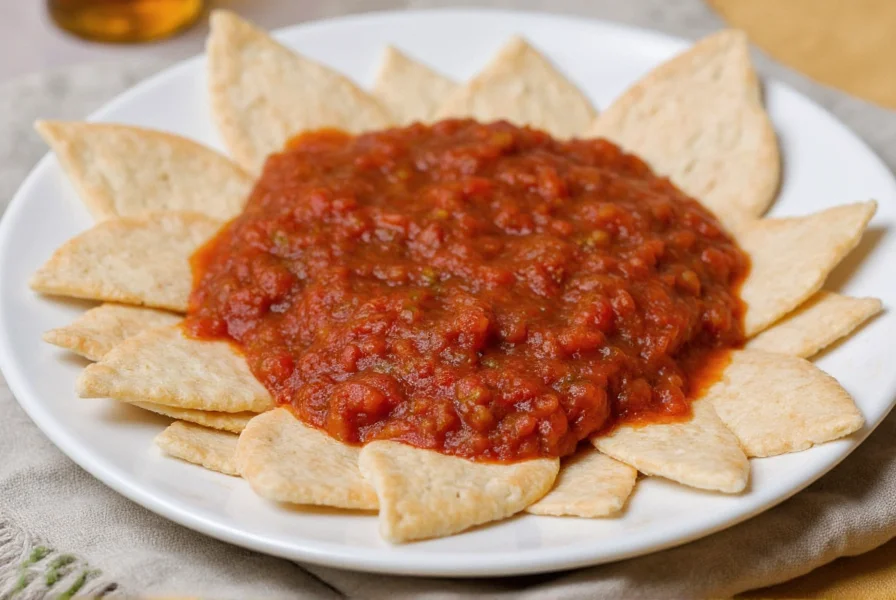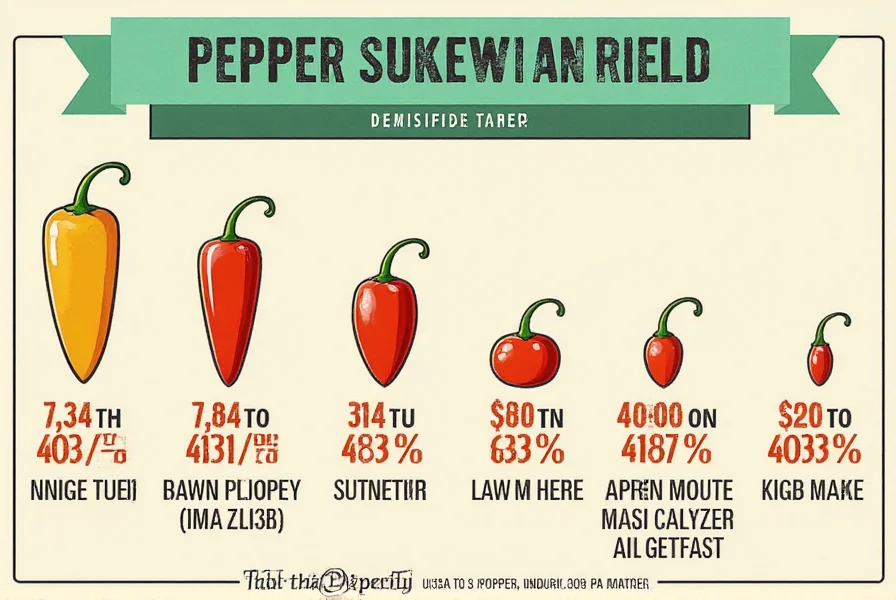Pepper spice levels are measured on the Scoville Scale, which quantifies the heat of peppers based on capsaicin content. This guide explains how the scale works, lists common peppers with their heat levels, and provides practical tips for handling and cooking with different spice levels.
The Scoville Scale: Measuring Pepper Spice Level
The foundation of understanding pepper heat lies in the Scoville Scale, developed by pharmacist Wilbur Scoville in 1912. This scale measures the amount of capsaicin (the compound responsible for spiciness) in a pepper and ranks it in Scoville Heat Units (SHU).

Capsaicin binds to pain receptors in the mouth, tricking your brain into thinking something hot is burning your tongue — even though there's no actual fire involved!
What Do the Numbers Mean?
- Mild: 0–1,000 SHU (e.g., bell peppers)
- Moderate: 1,000–50,000 SHU (e.g., jalapeños)
- Hot: 50,000–300,000 SHU (e.g., habaneros)
- Super-Hot: 300,000+ SHU (e.g., ghost peppers, Carolina Reapers)
| Pepper Name | Heat Level (SHU) | Taste Profile | Best For |
|---|---|---|---|
| Bell Pepper | 0 | Sweet, crisp | Stir-fries, salads |
| Jalapeño | 2,500–8,000 | Grassy, earthy | Tacos, nachos, salsas |
| Hatch Green Chile | 2,500–5,000 | Smoky, mild | Chili rellenos, sauces |
| Serrano | 10,000–23,000 | Fruity, bright | Salsas, pickling |
| Habanero | 100,000–350,000 | Fruity, floral | Hot sauces, tropical dishes |
| Ghost Pepper (Bhut Jolokia) | ~1,000,000 | Earthy, intense | Extreme chili challenges |
| Carolina Reaper | 1,500,000–2,200,000 | Fruity, smoky, explosive | World record holders only! |

Spice Handling Tips You Need to Know
If you've ever accidentally rubbed your eye after chopping a jalapeño, you know that capsaicin doesn't mess around. Here are some essential tips for safely working with spicy peppers:
- Wear gloves when cutting or handling hot peppers — especially super-hot ones like habaneros or ghost peppers.
- Rinse hands with milk or vinegar if you don't have gloves — water won't help remove the oils!
- Remove seeds and membranes to reduce heat. That's where most of the capsaicin lives.
- Use ventilation when roasting or grinding chiles to avoid inhaling irritating fumes.
- Store cut peppers in an airtight container in the fridge for up to a week or freeze them whole for later use.
Buying Guide: Choosing the Right Pepper for Your Palate
When selecting peppers, consider both flavor and heat. Here are some standout products to look for at your local grocery store or farmers market:
Product Spotlight: Dried Ancho Chiles
- Flavor Profile: Smoky, sweet, with hints of dried fruit.
- Pepper Spice Level: 1,000–2,000 SHU (mild).
- Best Uses: Mole sauces, stews, soups.
- Target Audience: Home cooks who enjoy Mexican cuisine.
- Recommended Occasions: Weeknight dinners, dinner parties.
Product Spotlight: Fresh Habanero Peppers
- Flavor Profile: Tropical, citrusy, with a floral finish.
- Pepper Spice Level: 100,000–350,000 SHU (hot).
- Best Uses: Caribbean jerk sauces, fruity hot sauces, grilled meats.
- Target Audience: Adventurous home chefs, hot sauce lovers.
- Recommended Occasions: Summer cookouts, backyard barbecues.
Product Spotlight: Ghost Pepper Powder
- Flavor Profile: Earthy, smoky, extremely hot.
- Pepper Spice Level: ~1,000,000 SHU (super-hot).
- Best Uses: Seasoning for extreme spice lovers, DIY hot sauces.
- Target Audience: Thrill-seekers, chili-heads.
- Recommended Occasions: Chili cook-offs, challenge eating.
Cooking with Different Pepper Spice Levels
Understanding how to balance flavor and heat in your cooking can elevate any dish. Here's how to get the best results depending on the pepper spice level you're using:
- Mild Peppers (0–1,000 SHU) – Use raw in salsas, sliced in sandwiches, or roasted for dips and sauces. Try stuffed bell peppers filled with rice, ground meat, and cheese for a classic comfort meal.
- Moderate Peppers (1,000–50,000 SHU) – Add depth to tacos, enchiladas, and egg dishes. Roast Hatch chiles for a rich green chili sauce that pairs perfectly with eggs or cornbread.
- Hot Peppers (50,000–300,000 SHU) – Ideal for sauces, marinades, and glazes. A few slices of habanero in a mango salsa will bring tropical heat to your grilled chicken tacos.
- Super-Hot Peppers (300,000+ SHU) – Handle with care! Use sparingly in small amounts for bold flavors. Infuse oils or create homemade hot sauces with caution.
Pro Tip: Cooking Reduces Heat
Cooking peppers can mellow their heat slightly, while drying intensifies it. If you want more control over the pepper spice level in your meals, experiment with fresh vs. dried versions of the same pepper.
How to Cool Down When It's Too Spicy
We've all been there: one bite too many, and suddenly your mouth feels like it's on fire. But fear not — here are some quick ways to soothe the burn:
- Milk – The protein casein neutralizes capsaicin better than water.
- Yogurt or sour cream – Great for dolloping on tacos or burritos to temper heat.
- Sugar or honey – Capsaicin loves fat and sugar; these can offer temporary relief.
- Rice or bread – Absorbent carbs help dilute the heat in your mouth.
- Avoid alcohol – Surprisingly, it can spread the heat instead of cooling it down.
Frequently Asked Questions About Pepper Spice Levels
What is the Scoville scale and how does it work?
The Scoville scale measures the heat level of peppers by determining their capsaicin concentration. Developed by Wilbur Scoville in 1912, it originally used human testers to determine how much sugar water was needed to neutralize the heat. Today, high-performance liquid chromatography (HPLC) provides more accurate measurements, which are then converted to Scoville Heat Units (SHU) for consistency with the original scale.
Which pepper is the hottest in the world?
As of current records, the Carolina Reaper holds the Guinness World Record for hottest pepper, measuring between 1.5-2.2 million Scoville Heat Units. However, newer contenders like the Dragon's Breath and Pepper X have been reported to exceed these levels, though they haven't been officially certified. The Pepper X was verified by Guinness World Records in 2023 as the new hottest pepper at 2.69 million SHU.
Why do some peppers taste fruity despite being hot?
Many hot peppers, especially habaneros and scotch bonnets, contain flavor compounds that create fruity notes alongside the heat. These aromatic compounds (like esters) interact with your taste receptors to produce flavors reminiscent of apricot, citrus, or tropical fruits. The combination of capsaicin (heat) and these flavor compounds creates a complex sensory experience that many hot sauce enthusiasts enjoy.
How can I reduce the heat of a pepper when cooking?
To reduce pepper heat, remove the seeds and white membranes (placenta) where most capsaicin concentrates. Soaking cut peppers in vinegar or salt water can also draw out some heat. When cooking, adding dairy products, sugar, or acidic ingredients like lime juice can balance excessive heat. Remember that cooking time affects heat levels - longer cooking can sometimes mellow the heat, while drying intensifies it.
Why does milk help with spicy food?
Milk contains casein, a protein that binds to capsaicin (the compound that makes peppers hot) and helps wash it away from your pain receptors. The fat content in milk also helps dissolve capsaicin, which is fat-soluble. This is why full-fat dairy products like whole milk, yogurt, or sour cream work better than skim milk for cooling your mouth after eating spicy food.
Can you build tolerance to spicy foods?
Yes, you can gradually build tolerance to spicy foods through repeated exposure. When you eat capsaicin regularly, your pain receptors become temporarily desensitized, allowing you to handle higher heat levels. This process is temporary though - if you stop eating spicy foods for a period, your tolerance will decrease. Start with milder peppers and gradually work your way up to hotter varieties to safely build your tolerance.
Are hotter peppers healthier?
All peppers contain beneficial vitamins and antioxidants, but hotter peppers typically contain more capsaicin, which has been linked to several health benefits including pain relief, improved metabolism, and reduced inflammation. However, "healthier" depends on your individual needs - milder peppers like bell peppers are rich in vitamin C and other nutrients without the intense heat. The health benefits come from regular consumption of peppers in general, not specifically from higher heat levels.
Does the heat of peppers change when cooked?
Yes, cooking affects pepper heat in complex ways. Initially, cooking can release more capsaicin, making the dish temporarily hotter. However, prolonged cooking can break down some capsaicin, reducing overall heat. Drying peppers concentrates the capsaicin, making them significantly hotter than their fresh counterparts. Roasting can also caramelize natural sugars in peppers, creating a flavor balance that makes the heat seem less intense even if the actual capsaicin level remains the same.
How should I store fresh peppers to keep them longer?
Store fresh peppers in the crisper drawer of your refrigerator in a paper bag or ventilated container. Avoid plastic bags that trap moisture, which can cause premature spoilage. Most peppers will last 1-2 weeks this way. For longer storage, freeze whole peppers (they'll become softer when thawed but retain flavor and heat) or slice and freeze them on a baking sheet before transferring to freezer bags. Drying or making them into hot sauce are also excellent preservation methods.
What's the difference between heat and flavor in peppers?
Heat in peppers comes solely from capsaicin compounds, measured on the Scoville scale. Flavor, however, comes from a complex mix of sugars, acids, and aromatic compounds that create taste profiles like sweet, smoky, fruity, or earthy. Two peppers with similar heat levels can taste completely different - for example, a cayenne pepper (30,000-50,000 SHU) has a sharp, straightforward heat, while a habanero at similar heat levels offers complex tropical fruit notes. Understanding both elements helps you choose peppers that complement your dishes beyond just adding heat.
Final Thoughts on Pepper Spice Level Mastery
Whether you're a mild-mannered eater or a full-blown chili connoisseur, knowing your pepper spice levels opens up a world of culinary creativity. By experimenting with different varieties, preparation methods, and pairings, you can customize every bite to your taste.
Don't be afraid to explore beyond your comfort zone — sometimes the best flavors come from the boldest bites. And remember, spice is subjective. What's blazing to one person might be barely a tingle to another. So find your sweet (or fiery!) spot and let the flavor adventure begin!
Stay tuned for more spice insights and flavor adventures right here!










 浙公网安备
33010002000092号
浙公网安备
33010002000092号 浙B2-20120091-4
浙B2-20120091-4